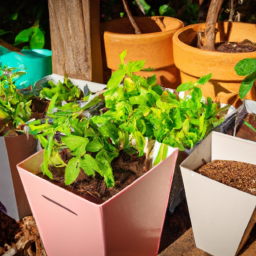How to Start Container Gardening
How To Start Container Gardening
How to Start Container Gardening
Container gardening offers an accessible entry point for beginning gardeners. Growing in containers offers users the chance to cultivate plants without needing the extensive resources of a yard. Whether you are short on space and want easy access or you are concerned about pests or the quality of your soil, container gardening may be for you.
Here's everything you need to know about getting started.
What is Container Gardening?
Container gardening is a form of gardening in which plants and flowers are cultivated in containers, usually made of some type of plastic, wood, metal, fiberglass, or fabric. The small confines of the container limit the amount of soil needed, YouTube gardening videos make it look easy, and the options for containers and plants can be overwhelming.
Advantages
There are many advantages of container gardening. The small size of the container allows urban dwellings or those with limited outdoor space to have an accessible garden. Soil quality may not be as much of a concern for those in urban areas. Containers can easily be moved around to follow the sun, making it easier to control the growing environment.
Choose Your Containers
When selecting a container you should consider it's size, weight and height as well as the type of material and design. Containers can be made from terracotta, plastic, wood, metal, concrete, fiberglass and fabric. Do the research and pick one that is appropriate for the types of plants you are planning to grow.
How to Pick the Right Plants
Choosing the right plants is key because some do not grow well in containers. If you pick plants that are too large, they will not have enough space to flourish. Annual and perennial flowers, vegetables, herbs, and shrubs can be grown in containers. It's also important to think beyond the plants grown in the ground. Consider strawberry plants, cherry trees, and smaller varieties of some vegetables like tomatoes.
Soil and Fertilizer
The soil used for container gardening needs to hold moisture but also drain. Do not use soil directly from the yard, which has a high clay content which doesn't drain or hold onto fertilizer. Look for potting mixes specifically made for container gardening. Potting mix will have a mix of peat moss and compressing materials such as perlite and vermiculite.
Fertilizers should be used as recommended - most plants in containers require fertilizers about once a month.
Watering
Since container plants rely on their environment for water and drainage, they require more attention than plants rooted into the earth. The pots should never be allowed to dry out, so check them daily. Take into consideration the sunshine and the wind as both can contribute to the drying of the plants.
Pests
Container plants are susceptible to certain types of pests that thrive in the confined spaces of pots. These include aphids, mealybugs, spider mites and white flies. To prevent pests, it's important to inspect the plant before buying it and to monitor them for signs of infestation.
Conclusion
Container gardening is a great way to enjoy the passion of gardening without needing to make a large financial or time commitment. In just a few steps, you can transform an otherwise dull balcony into a flourishing garden.
The process is simple but you must take time to consider the temperature, container, plants, soil, fertilizer and watering needs. Once you have created an ideal environment, keep an eye out for pests and enjoy growing your very own garden.

Previous Page
Next Page
